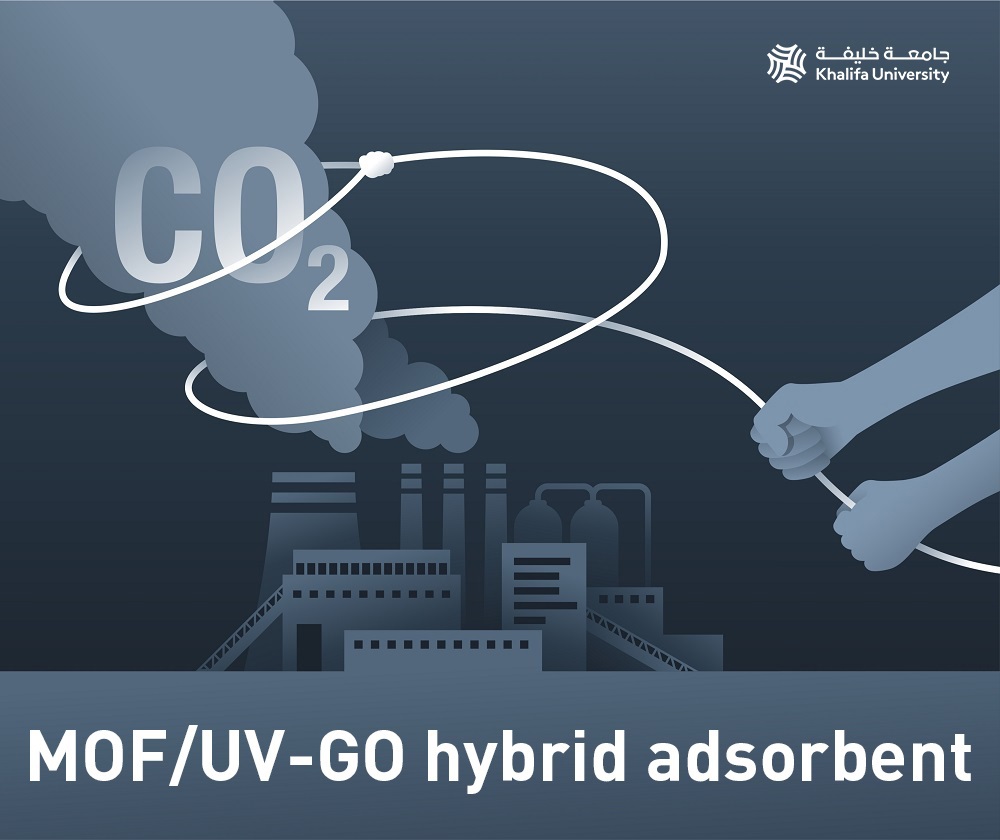
Carbon capture technology can be further improved for efficiency by simply irradiating one of the components, according to research from a Khalifa University team of chemical engineers
Reducing greenhouse gas emissions, particularly carbon dioxide (CO2), is paramount in combating climate change. Along with a paradigm shift from fossil fuels to renewable energy sources, deployment of carbon capture and storage technologies is a key strategy to actively limit the global average rise in temperature to less than 1.5 ⁰C relative to pre-industrial levels.
Carbon capture, utilization and storage (CCUS) is the most widely accepted and promising strategy for mitigating point source CO2 emissions, with technologies being increasingly demonstrated across a number of industries globally. These technologies typically include capturing CO2 from emission sources such as power plants, followed by compression prior to transportation to long-term storage sites. These approaches can be further improved for increased efficiency and reduced energy consumption and cost.
A research team from Khalifa University has investigated hybrid adsorbents, combining a metal-organic framework (MOF) with UV-irradiated graphene oxide, to create a highly effective and efficient carbon capture material. The team found that activating the graphene oxide using ultraviolet light improves the surface, structural, and morphological properties for enhanced selective carbon dioxide affinity.
Team members included Eng. Anish Mathai Varghese, Research Associate, Dr. K. Suresh Kumar Reddy, Research Scientist, and Dr. Georgios Karanikolos, Associate Professor of Chemical Engineering. Their results were published in Chemical Engineering Journal.
Successful carbon capture needs a sorbent material that will selectively grab CO₂ in a stream of mixed gases and then readily release it when desired so that the material can be reused, while the captured CO₂ can be utilized or sent for long-term storage.
In adsorption, CO₂ collects in the pores in the material that serve as active capture sites. When, for instance, temperature is lowered, CO₂ adheres to the surface, and when temperature is raised, CO₂ is released. Changes in pressure can also bring about these capture and release cycles.
Currently, aqueous amine solutions, which are solutions containing water and organic compounds called amines that contain nitrogen atoms attached to hydrogen and carbon atoms, are used to capture CO₂ in industrial applications. Amine solutions are excellent at capturing the CO₂, making them the most popular and developed carbon capture technology. However, their disadvantage is that in order to recover the trapped CO₂ from the amine solution, the solution has to be heated, requiring large amounts of thermal energy and resulting in some amines being lost to the environment in this high-energy process.
To overcome the shortcomings of amine solutions, solid sorbent materials are a viable alternative. Solid sorbents can selectively adsorb CO₂, however some solid sorbent materials perform better than others.
“Adsorption is gaining increased attention due to advantages that include low energy consumption, ease of implementation, cost-effectiveness, and generation of harmless byproducts,” Eng. Varghese explained. “To be suitable for large scale carbon capture, however, the adsorbent materials need to offer certain features and properties, including low energy consumption, chemical and thermal stability, low manufacturing cost, and mechanical robustness. As such, a large variety of materials are being investigated globally, like metal-organic frameworks, zeolites, covalent organic materials, and porous polymers, among many others. We developed a hybrid metal-organic framework adsorbent using copper ions, and UV-activated graphene oxide.”
Metal-organic frameworks offer superior textural properties, high structural flexibility, and can be combined with various functional groups for different applications. However, MOFs typically possess low thermal and chemical stability, restricting their use in harsh environments. To overcome this, the research team used a MOF-based hybrid known as HKUST-1 or MOF-199. This MOF is particularly promising for CO2 capture thanks to its extended porous structure with large surface area and pore volume, along with good chemical stability, ease of synthesis and commercial viability. It is a 3D porous framework combining copper ions with oxygen atoms.
To further improve stability, the research team focused on developing a hybrid with MOF-199 and graphene oxide (GO), since GO has been shown to improve carbon capture performance in previous research. The team went a step further too: they used UV-irradiated graphene oxide to increase the hybrid MOF’s CO2 adsorption capacity by 45 percent.
UV irradiation of the graphene oxide affected the distribution of the copper ions on the surface of the resulting MOF, which enhanced the pore shape and structure to allow for better CO2 selectivity and adsorption.
“These results show that UV treatment is a simple and scalable technique that can enhance the characteristics and performance of MOF/GO hybrid adsorbents for CO2 capture,” Eng. Varghese said. “Our hybrid material is an excellent adsorbent in humid conditions, which is beneficial since water vapor is often present in CO2-containing mixtures, such as in post-combustion of fuels.”
This material now has the potential to be further developed and scaled-up, with UV activation of graphene before capture application serving as an easy and low-cost pre-treatment technology.
Jade Sterling
Science Writer
12 April 2022






